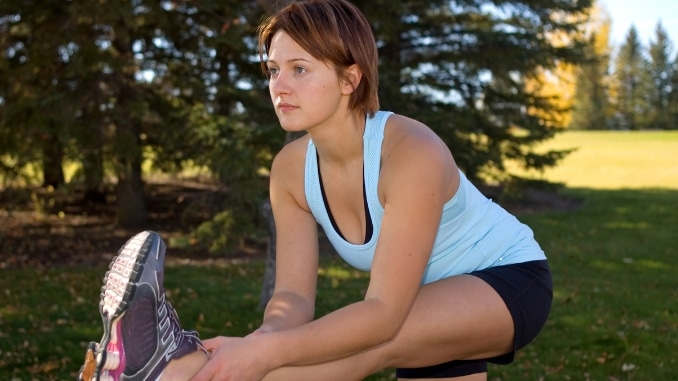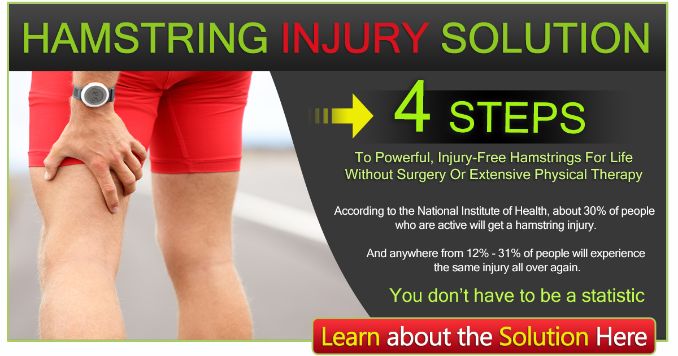Medical Disclaimer: The information in this blog is for enlightening and educational purposes only and is not intended as medical advice. The content in this post is not meant to substitute for a professional medical diagnosis, advice, or treatment. Always ask advice from your physician or other qualified health providers with any questions you may have regarding a medical condition.
Tight hips and hamstrings are common and can lead to problems like lower back pain, knee pain, and poor posture. Regular stretching can boost your mobility and reduce the risk of injury.
Tight hip flexors, in particular, can contribute to issues such as hamstring tightness [1], lower back pain, sciatica, painful hip flexors, and knee discomfort. The key is to stretch the affected muscles and strengthen those that support the hips.
- Hip Muscles: Include the psoas major and iliacus (hip flexors) and the gluteus maximus (hip extensor). Other key hip muscles are the gluteus medius/minimus and adductors.
- Hamstrings: Composed of three muscles—biceps femoris, semitendinosus, and semimembranosus—located at the back of the thigh, they are responsible for knee flexion and hip extension.
1. Side-Lying Clam
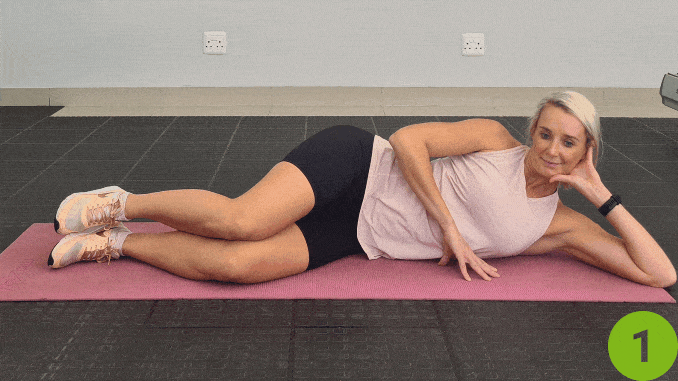
- Lie on your side on the floor with your knees bent and stacked together.
- Maintain good alignment with your head, shoulders, and hips.
- Bend your bottom arm and place it on the side of your neck to prop up and support your head.
- Place your top arm in front of you to support your body.
- Ensure your top arm rests lightly before your torso without pressing into the ground to stabilize.
- Tighten your abdominal muscles.
- Lift your top knee to open your legs while keeping your feet together.
- Lower it down to return to the starting position and repeat the movement 10 repetitions.
- Relax and repeat the movement on the opposite side.
2. Hamstring Wall Stretch
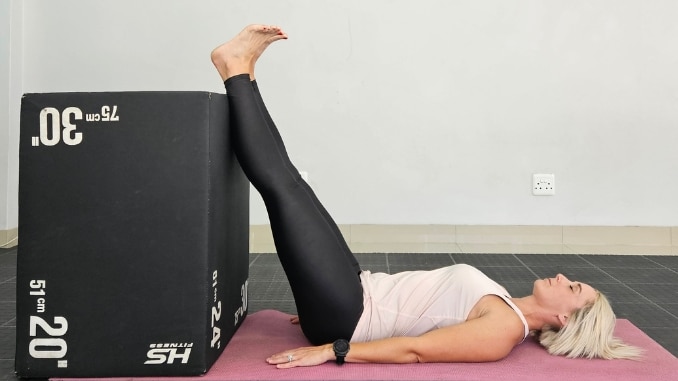
- Lie on your back with your hips close to the wall and extend your legs upward, resting them on the wall.
- Keep your knees slightly bent if needed.
- Gradually scoot closer to the wall as flexibility improves.
- Maintain good alignment with your head, shoulders, and hips.
- Tighten your abdominal muscles.
- Lift and place your legs up on a wall with your feet close together, and place your hands at your side with palms pressed on the floor.
- Hold the position for several deep belly breaths, in through your nose and out through your mouth.
3. Hip Flexor Stretch
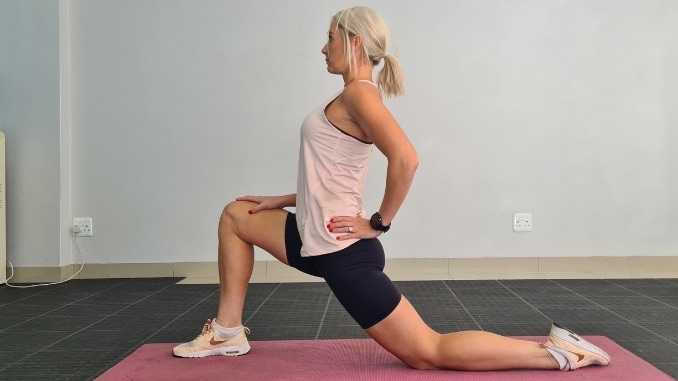
- For this exercise to relieve tight hamstrings and hip flexors, begin in an upright standing position with your feet hip-width apart, maintaining good alignment with your head, shoulders, hips, and legs.
- Step forward with one foot, position your front leg at a 90-degree angle, and kneel your back leg.
- Untuck your toes and press your leg firmly on the floor.
- Place your hands on your hips.
- Engage your core and move your hips forward while keeping your spine straight.
- Hold the position for several deep belly breaths, in through your nose and out through your mouth.
- Relax and repeat the movement on the opposite side.
4. Bridges
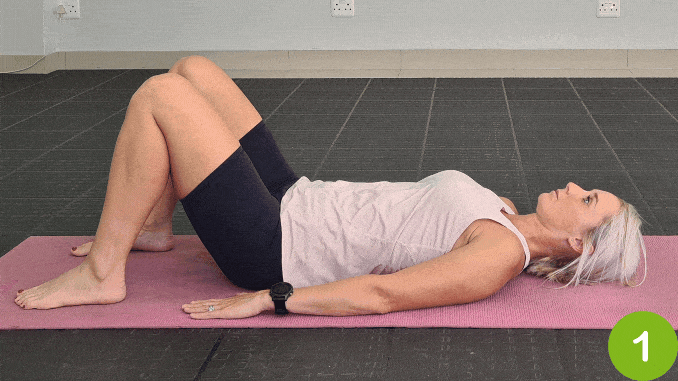
- Lie on your back with your knees bent and your feet flat on the floor, relaxing your upper body.
- Place your arms at your side.
- Contract your abdominal area, then push from your heels to lift your hips.
- Maintain good alignment with your head, shoulders, hips, and knees.
- Hold this position for several deep belly breaths, in through your nose and out through your mouth.
- Relax and return to the starting position.
5. Leg Swings

For this exercise, utilize the wall or a chair for support if needed.
- Begin in an upright standing position with your feet hip-width apart, maintaining good alignment with your head, shoulders, hips, and legs.
- Place one hand at the back of the chair for support and the opposite hand on your hip.
- Engage your core.
- Place your weight on one leg and swing your opposite leg back and forth in a slow and controlled manner.
- Repeat for 10 repetitions.
- Relax and repeat the movement on the opposite side.
6. Deep Squat
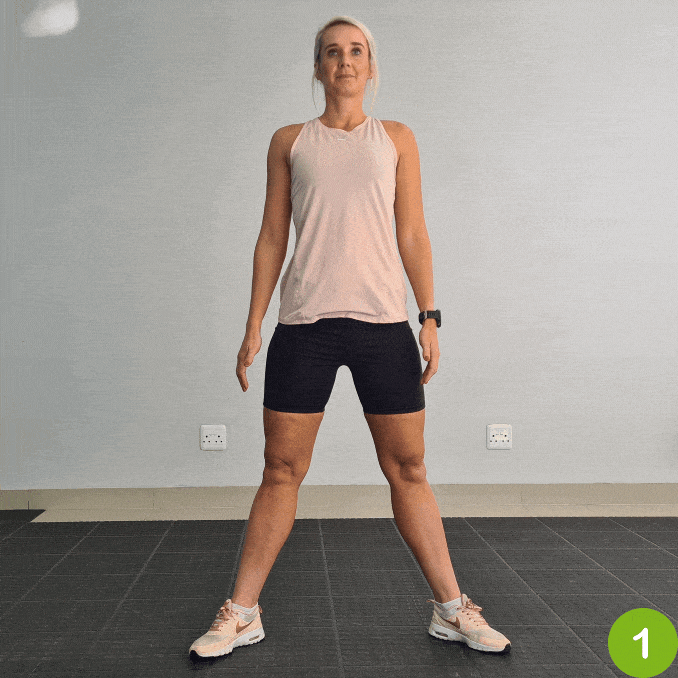
- Begin in an upright standing position with your feet wider than hip-width apart and your toes pointing slightly outward.
- Maintain good alignment with your head, shoulders, and hips.
- Place your hands at your sides.
- Engage your core.
- Bend both knees to lower your body into a deep squat position as you press your palms together at chest level.
- Hold the position for a couple of seconds.
- Raise back up to return to the starting position and repeat the movement for 10 repetitions.
7. Hip Hinge
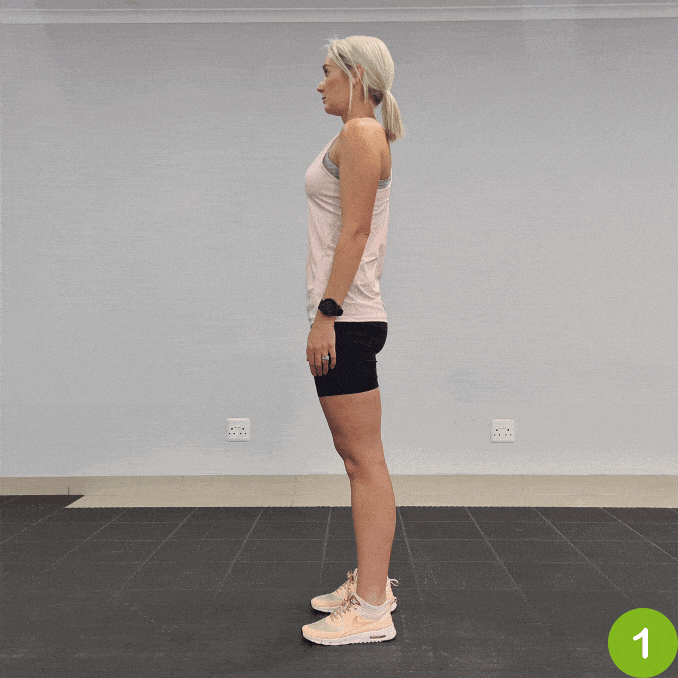
- Begin in an upright standing position with your feet hip-width apart, and maintain good alignment with your head, shoulders, hips, and legs.
- Place your hands on your sides.
- Engage your core.
- Hinge through your hips to move your upper body forward as you reach your hands toward the floor while keeping your spine neutral.
- Hold the position for several deep belly breaths, in through your nose and out through your mouth.
- Return to the starting position and repeat the movement for 5 repetitions.
8. Leg Lift and Reach

- Begin in an upright standing position with your feet hip-width apart, maintaining good alignment with your head, shoulders, hips, and legs.
- Place your hands on your sides.
- Engage your core.
- Place all your weight on one leg, then lift and straighten one leg up as you reach your toes with your opposite hand while keeping your back straight.
- Lower your leg to return to the starting position and repeat the movement on the opposite side.
- Repeat the movement on each side for 10 repetitions.
This exercise helps improve balance, flexibility, and strength in the hip flexors.
How Tight Hip Flexors Affect Your Body
When your hip flexors are tight, they can cause pain in the lower back, hips, and knees. Here’s why:
- Tight hamstrings can limit the range of motion [2] in the pelvis and trunk during forward bending (like when you touch your toes).
- It may lead to compensations in the lumbar spine (lower back), increasing the strain on spinal tissues and causing lumbar pain.
- The hip joint is a ball-and-socket joint that allows a lot of movement, but it needs strong muscles to stay stable. Without strength, the hip joint can become unstable, causing pain or discomfort in different areas of your body.
Symptoms of Tight Hamstrings and Hip Flexors
- Lower Back Pain
- Limited Range of Motion
- Knee Pain
- Hip Discomfort
- Walking/Running Difficulty
- Postural Imbalances
Strengthening Exercises for Stronger Hips and Hamstrings
According to Dr. Yalin Wang, tightness in the hips can be addressed by doing exercises that stretch the gluteal muscles. If we don’t stretch regularly, the muscles around the hips, including the hip flexors, can weaken and shorten over time, often going unnoticed until discomfort arises. Stretching helps reverse the hip flexor shortening caused by prolonged sitting and improves overall flexibility and mobility in the hip area.
Conclusion
Tight hamstrings and hip flexors can lead to pain and poor mobility. Regular stretching and strengthening [3] exercises help improve flexibility, reduce discomfort, and prevent injury.
Incorporating simple exercises like leg swings, hip hinges, and bridges into your routine can keep your muscles healthy and improve overall movement.
If you want to get rid of your stubborn hamstring injury once and for all, then click here to check out the Hamstring Injury Solution program here.
Frequently Asked Questions
Which hamstring muscle is often injured during toe-off?
Biceps femoris. The biceps femoris is the hamstring muscle most commonly injured when you push off the ground during activities like running.
Which hamstring muscle is most often injured?
Biceps femoris. The biceps femoris is the most commonly injured hamstring muscle, especially in sports or activities that involve running.
What is the best remedy for hip pain?
According to Dr. Robert H. Shmerling, a Harvard Health Professional, the best remedy for hip pain depends on the cause. For minor injuries, rest, heat, cold therapy, and over-the-counter pain relievers can be helpful, along with gentle exercises. If the pain persists, cortisone injections or anti-inflammatory medication may be used. For more serious hip pain, such as pain that does not improve or is accompanied by symptoms like fever or an inability to walk, seeking medical evaluation is important.
How to fix tight hamstrings and hip flexors?
Stretching and strengthening exercises can help. Focus on stretches like lunges and leg swings to loosen the hip flexor muscle group. Strengthening exercises, such as bridges and hip hinges, will help correct an anterior pelvic tilt and improve flexibility in both the hamstrings and hip flexors.
What is the fastest way to loosen tight hamstrings?
Gentle stretching and foam rolling can quickly loosen tight hamstrings. Try stretches like standing hamstring stretches, or use a foam roller to target the muscle group and release tension from the hamstrings and hip flexors.

